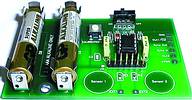2-channel programmable touch sensor chip
14 August 2002
Electronics Technology

Quantum Research Group has released the QT320, claimed to be the world's first programmable touch sensor IC. The 8-pin part is based on Quantum's proprietary 'QProx' charge-transfer ('QT') technology.
It is a self-contained digital IC with a RISC core having two sensing channels. It can be used to create 'virtual buttons' through glass, plastic, stone, ceramic, and even wood. It can also turn small objects into touch controls.
The QT320 is designed specifically for human interfaces, for example in appliances, lighting controls, computer peripherals or anywhere a mechanical switch or button may be found; it can also be used for some material sensing applications. According to the company, the QT320 represents a new price point for its QProx touch sensor chips; the price per channel represents a 33% reduction per sensing channel over Quantum's QT110 family.
The QT320's RISC core uses signal-processing techniques pioneered by Quantum, designed to make the device survive real-world challenges such as 'stuck sensor' conditions and drift. The chip's EEPROM and communications port lets the user program the device from a PC using Quantum-supplied software. All operating parameters can be user-loaded into the part's internal EEPROM to configure sensitivity, drift compensation rate, response time, and output polarity. The part also features user-configurable automatic recalibration and output toggle mode.
The QT320 requires only an inexpensive capacitor per channel to function. Power consumption and speed can be traded off depending on the application; drain can be as low as 60 µA, allowing battery operation. Both 8-pin DIP and SOIC packages are available; and it is temperature rated for -40 to +85°C.
Further reading:
140 W USB-C PD reference design
Altron Arrow
Electronics Technology
The design has a wide input range of 90 to 264 V AC, 50-60 Hz, and supports an output voltage range of 5 to 28 V (USB-PD 3.1 specification).
Read more...
Nanometre-precision piezo actuators
RS South Africa
Electronics Technology
TDK Corporation has announced two new piezo actuators that are characterised by a wide dynamic range, a high force-to-volume ratio, but with precision in the nanometre range.
Read more...
Webinar: The evolving electrification of the power distribution system
Electronics Technology
New connected car functionality, along with the necessity to reduce the cost, weight and complexity associated with wire harnesses, has led to the transformation of the power distribution system in automotive engineering.
Read more...
Improved MnZn material for power conversion industry
Sivan Electronic Supplies
Electronics Technology
Cosmo Ferrites Ltd, a leading manufacturer of soft ferrites, has launched an improved version of CF295 for the power conversion industry.
Read more...
Common mode filter for automotive Ethernet
Avnet Abacus
Electronics Technology
TDK Corporation has announced the introduction of its new ACT1210E Series common mode filter for automotive Ethernet 10BASE-T1S.
Read more...
Energising the industrial edge
Electronics Technology
As if the drive to decarbonise energy as part of sustainability and climate change efforts was not enough, the recent rise in energy prices has brought into sharp contrast the need to re-examine how we generate, distribute, and consume electricity.
Read more...
Samsung begins chip production using 3 nm process technology
EBV Electrolink
Electronics Technology
The optimised 3 nm process with GAA architecture achieves 45% lower power usage, 23% improved performance and 16% smaller surface area compared to 5 nm process.
Read more...
Panasonic releases its updated touch-sensitive knob
Altron Arrow
Electronics Technology
Panasonic, in conjunction with Microchip, has launched an update to its existing Magic Knob, a capacitive knob ready for standard touch sensors for use in controlling automotive information displays.
Read more...
Microchip’s new IC to replace Hall effect position sensors
Altron Arrow
Electronics Technology
The LX34070 IC from Microchip is set to help accelerate the global move away from expensive and less accurate magnet-based solutions for safety-critical EV motor position monitoring.
Read more...
A brief history of HBTs
Conical Technologies
Electronics Technology
In 1947 the engineers at Bell Labs were tasked with developing a transistor. This development heralded the beginning of the semiconductor industry which changed the world forever. Transistors would have
...
Read more...


